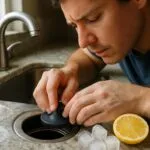Toilet bowls frequently accumulate stains over time, causing the bathroom to appear less tidy. Various stains require distinct cleaning methods. This article will demonstrate effective techniques for removing toilet bowl stains using both natural and commercial cleaners.
The sources of these stains and the most effective methods for removing them, whether they’re dark brown or black marks, or tough and persistent stains, will be revealed. Are you prepared to witness your toilet shine?
Beginning with, knowing the origin of toilet bowl stains plays a crucial part. The source could be mineral deposits from hard water or bacterial growth resulting in disagreeable marks, identifying the origin aids in selecting the appropriate cleaning plan.
For those who favor natural methods, baking soda and vinegar can be quite successful at eliminating toilet bowl stains. These ingredients are effective and safe for routine use, devoid of harsh chemicals.
Conversely, commercial cleaners deliver potent solutions for eradicating darker and more persistent stains that home remedies may not be able to handle as effectively.
In conclusion, regular upkeep can significantly help in maintaining toilets free from irritating stains. Routine cleaning deters accumulations and ensures your bathroom remains sanitary and visually pleasing.
Key Takeaways
- Natural cleaners such as vinegar, baking soda, and citric acid are effective in removing toilet bowl stains without using harsh chemicals. These substances dissolve rust, hard water deposits, and organic buildup.
- For those on a budget, a pumice stone is an effective tool for scrubbing away tough mineral deposits from the toilet surface without causing damage. It works well on hard water stains and other persistent marks.
- Commercial cleaning products offer a strong solution for eliminating stubborn toilet bowl stains. They are created to specifically address issues like rust or mineral buildup with efficiency.
- Regular cleaning routines can prevent the appearance of new stains by dealing with buildup promptly. Weekly maintenance keeps toilets sanitary and free of stains.
- The installation of a water softener can decrease the mineral content of hard water, which helps to avert the corresponding stains in toilets and is beneficial for plumbing maintenance.
Common Types of Toilet Bowl Stains
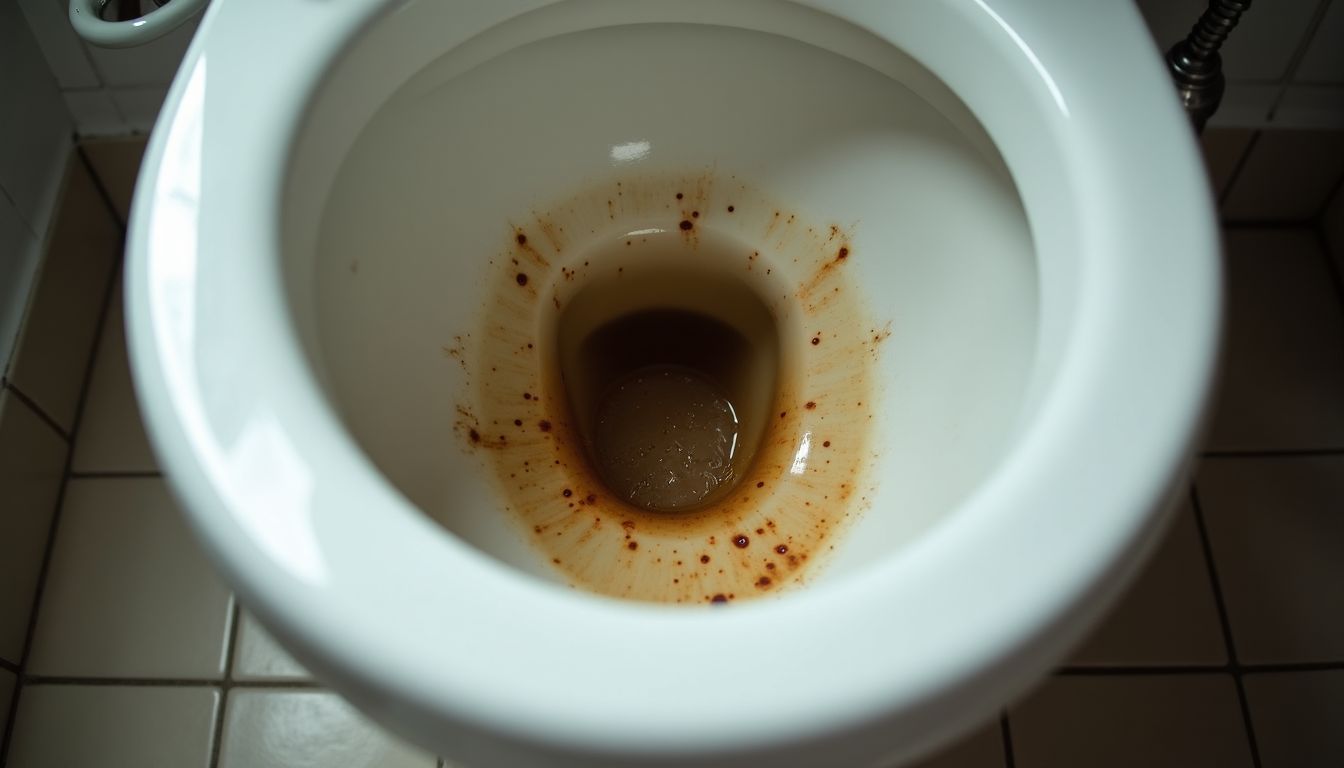
Toilet bowl stains come in various forms, including hard water stains, rust stains, and organic buildup. These blemishes can be unsightly and challenging to remove without the right approach.
Hard water stains
Hard water stains are common in many toilets due to high levels of minerals like calcium and magnesium in the water. These minerals accumulate over time, leaving tough, chalky marks.
Rings around the toilet bowl or streaks under the rim often indicate these stains. Special cleaning methods are necessary for removing hard water stains, as regular wiping isn’t effective.
Aside from hard water issues, homeowners and parents also deal with rust stains and organic buildup inside their toilets.
Rust stains
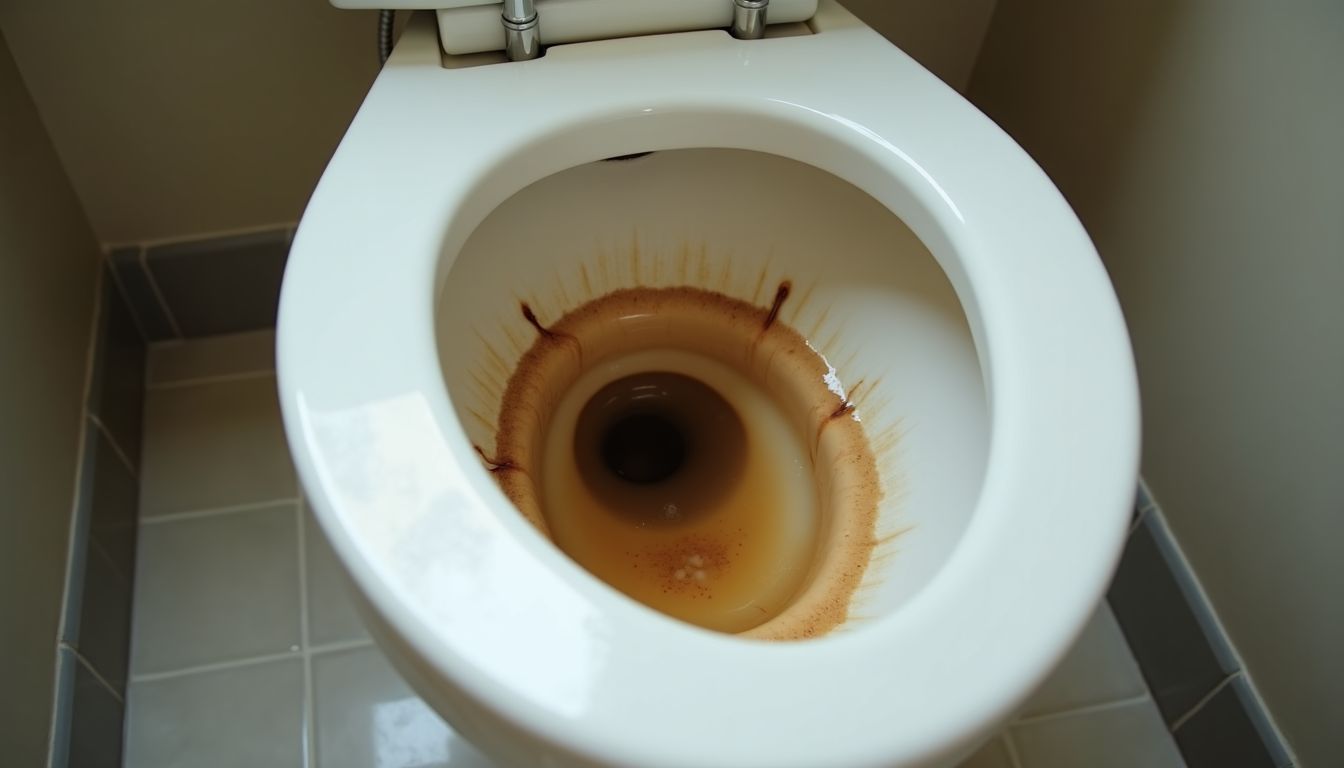
Hard water often leaves rust stains in toilet bowls, due to iron reacting with oxygen. These reddish-brown marks look bad and can stick permanently if ignored. Removing these stubborn stains poses a challenge without proper methods.
A mix of lemon juice and salt can remove rust effectively by creating a scrubbing paste. The acidity from the lemon dissolves the rust while the salt scrubs it away. For tougher cases, commercial cleaners specifically for rust removal are stronger but require careful use according to instructions.
Regular cleaning helps prevent stain buildup, making them simpler to clean later on.
Organic buildup
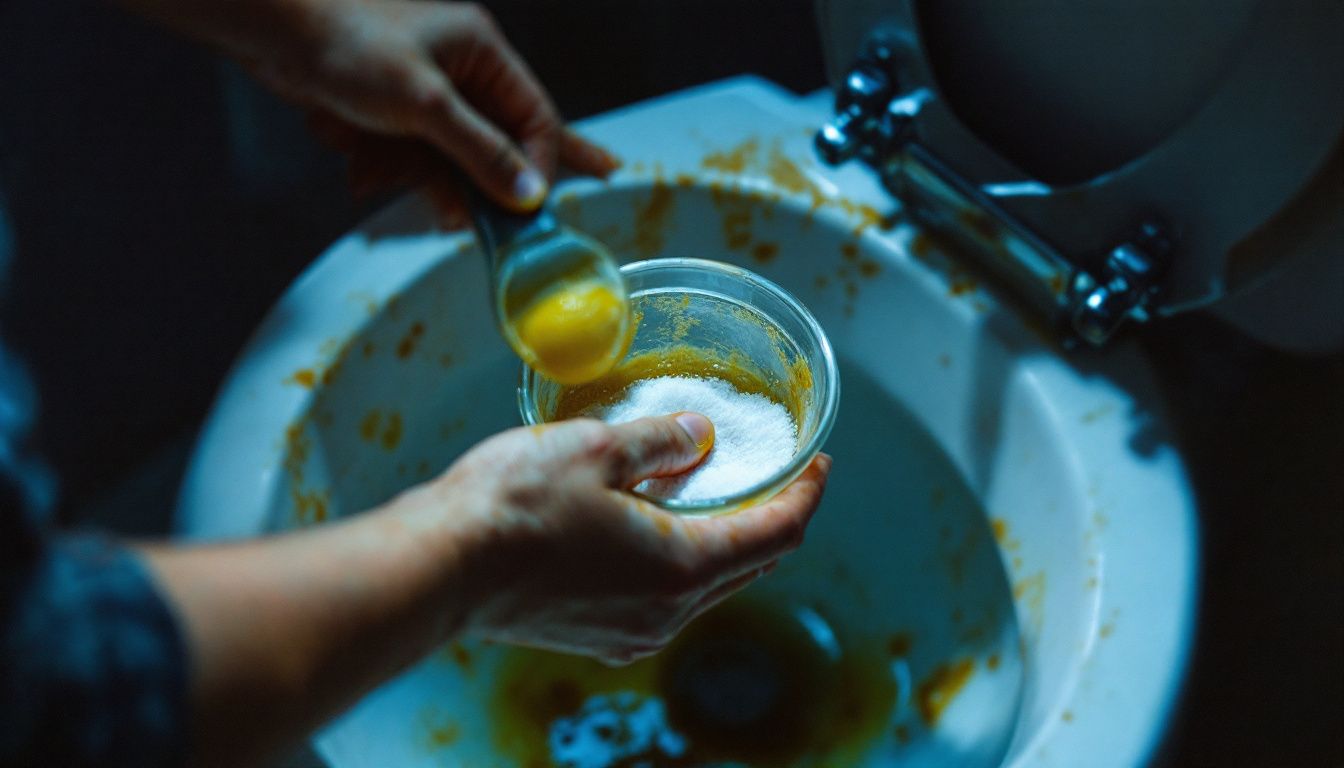
Urine and fecal stains contribute to organic buildup in toilet bowls, leading to unpleasant odors and discoloration. These stains cling to surfaces, making them hard to remove. Regular cleaners often don’t have the power to deal with these difficult stains.
Natural cleaning solutions, particularly vinegar, prove to be powerful tools for addressing these stubborn stains. They provide a secure method for parents and homeowners to uphold bathroom hygiene, removing the need for harsh chemicals.
Using baking soda along with vinegar boosts the cleaning process, effectively eliminating brown and black stains from the toilet bowl.
Adopting these natural techniques ensures a sanitary bathroom environment by efficiently clearing hard-to-remove marks and upholding sanitation standards. This method maintains household cleanliness and promotes safer cleaning habits.
Methods to Clean Toilet Bowl Stains
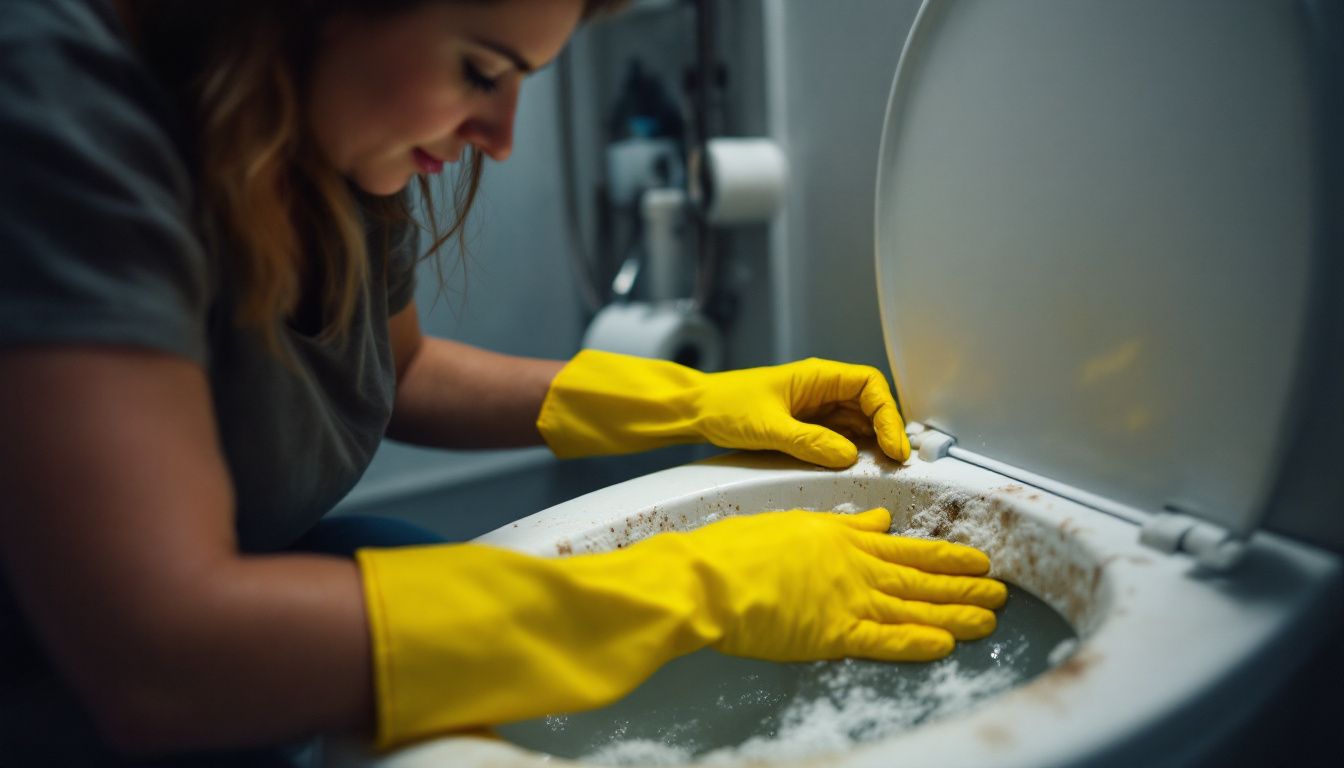
To clean toilet bowl stains, combine vinegar and baking soda for a natural cleaning solution. Try using a pumice stone to scrub away tough stains without damaging the porcelain.
Use vinegar and baking soda
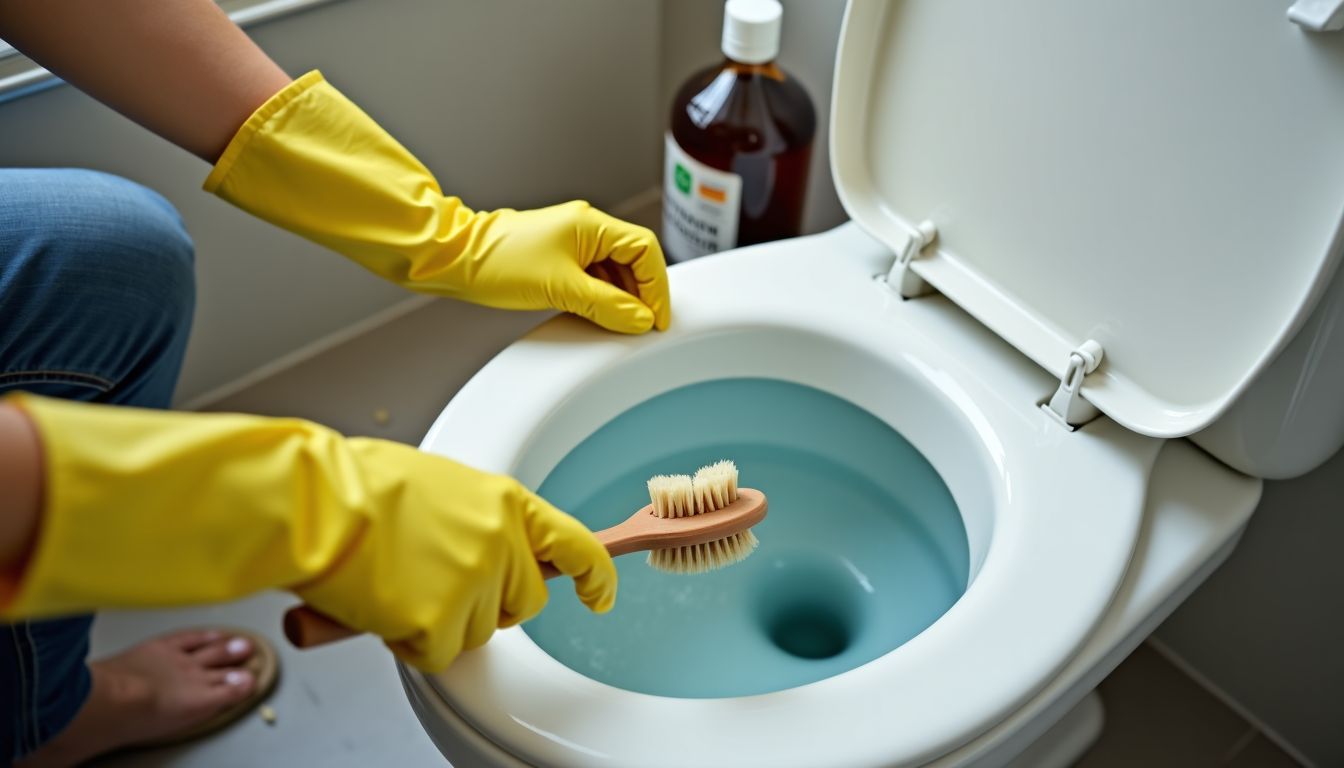
Vinegar and baking soda, two common household ingredients, are effective in eliminating toilet bowl stains. The acidic nature of vinegar helps dissolve tough stains like hard water deposits and rust discolorations.
Baking soda, on the other hand, acts as a gentle abrasive and aids in scrubbing away organic buildup without causing damage to the porcelain surface. To apply these natural cleaners effectively, start by pouring one cup of vinegar into the toilet bowl and letting it sit for several hours or overnight to address stubborn stains.
Then, sprinkle baking soda onto a cleaning brush or sponge before thoroughly scrubbing the bowl with it.
This simple yet powerful method not only eliminates unsightly stains but also freshens up the toilet bowl without harsh chemical fumes lingering in your home. After scrubbing, flush the toilet to reveal a cleaner surface.
This natural cleaning approach provides a safe and eco-friendly way to maintain a stain-free toilet bowl for a hygienic bathroom environment.
Try a pumice stone
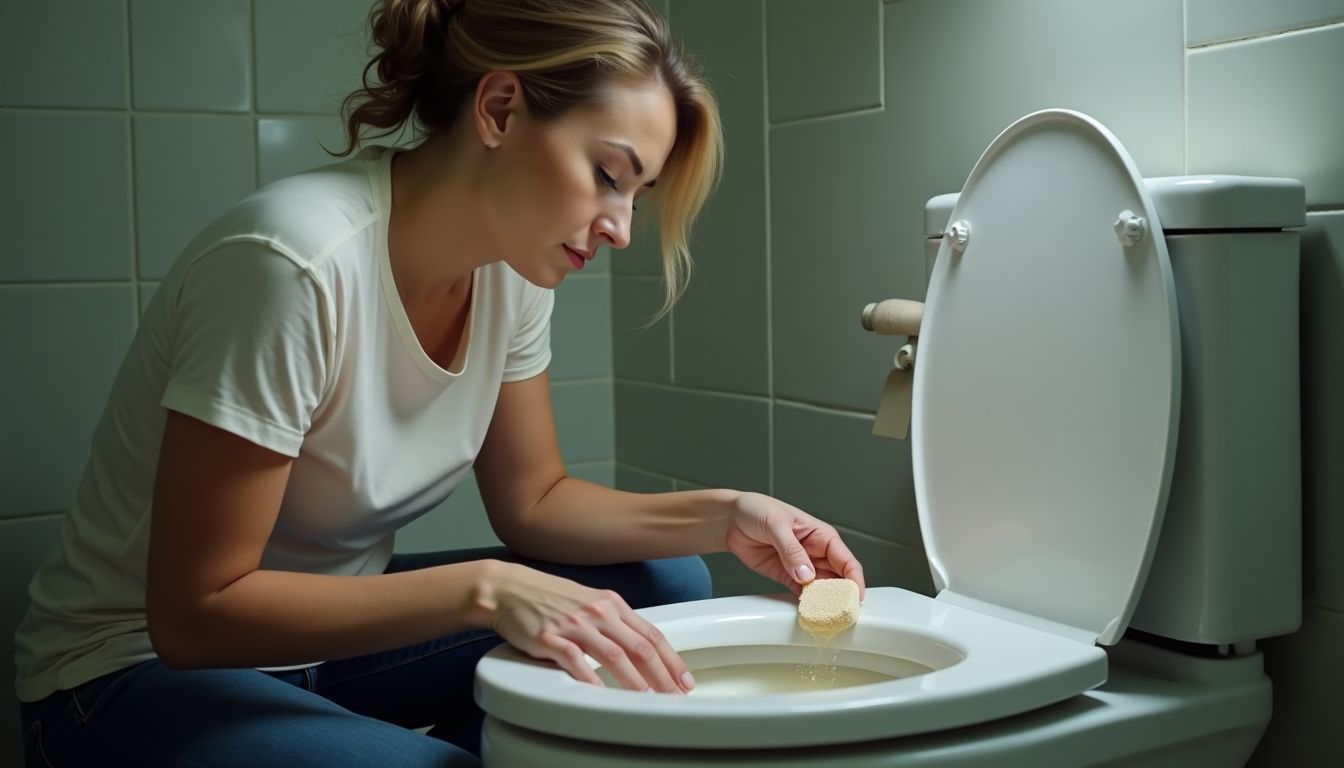
One effective method to remove tough stains from a toilet bowl is by using a pumice stone. This natural cleaning tool works by gently scrubbing away stubborn mineral deposits and other buildup without causing damage to the porcelain surface.
To use a pumice stone, wet it and rub it directly on the stain, applying light pressure until the stain begins to fade. This method is especially useful for hard water stains and mineral deposits that may be resistant to traditional cleaning methods.
Using a pumice stone for toilet bowl stains can be an eco-friendly and budget-friendly alternative to harsh chemical cleaners. House owners or parents looking for a natural approach to removing stubborn stains from their toilet bowls may find this method particularly appealing due to its effectiveness in tackling mineral deposits and other tough buildup.
However, it’s important to note that while using a pumice stone, users should ensure that both the stone and the toilet bowl’s surface are wet to prevent any scratching or damage.
Apply citric acid
To clean tough toilet bowl stains, homeowners can apply citric acid as an effective and natural solution. Citric acid provides a powerful cleaning action due to its acidic properties, making it particularly adept at breaking down hard water deposits and mineral buildup.
By sprinkling citric acid around the inside of the toilet bowl and allowing it to sit for several hours or overnight, followed by a thorough scrubbing with a toilet brush, individuals can effectively remove stubborn stains without harsh chemicals.
Citric acid not only helps in removing stains but also contributes to maintaining overall bathroom hygiene. As a natural cleaning agent, using citric acid aligns with the trend toward eco-friendly household maintenance.
This approach is especially beneficial for parents seeking non-toxic cleaning methods that ensure family safety while achieving pristine results.
Use commercial cleaning products
House owners and parents can benefit from using commercial cleaning products to effectively tackle tough toilet bowl stains. These products are formulated with powerful ingredients designed to target specific types of stains, such as hard water deposits or rust, ensuring a thorough and efficient cleaning process.
Moreover, commercial cleaners often come in convenient application formats, making it easier for users to achieve the desired results without extensive scrubbing or repeated applications.
By including reliable commercial cleaning products into their regular bathroom maintenance routine, homeowners can ensure a hygienic environment for their families while minimizing the time and effort required for stain removal.
By investing in reputable brands that offer effective solutions tailored towards eliminating stubborn toilet bowl stains, individuals can save both time and energy in addressing this household chore effectively before moving on to preventing future build-ups.
Tips to Prevent Toilet Stains

To prevent toilet stains, establish a regular cleaning schedule and use a water softener. Regular cleaning helps to avoid the buildup of stains, while a water softener reduces mineral deposits in the bowl.
Regular cleaning schedule
House owners and parents can maintain a clean toilet bowl by establishing a regular cleaning schedule. This entails dedicating specific times, ideally weekly, to thoroughly sanitize the toilet bowl and eliminate any stains or buildup.
By doing so, they can prevent tough stains from forming and ensure that the toilet remains hygienic for their family. A consistent cleaning routine also aids in identifying any emerging issues early on, allowing for timely intervention and preventing more significant problems down the line.
Establishing a regular cleaning schedule not only keeps the toilet bowl looking pristine but also contributes to maintaining overall bathroom hygiene. Adopting this practice ensures that house owners and parents proactively address any accumulating stains or discoloration, promoting a clean and comfortable environment for their household.
Install a water softener
To prevent the buildup of hard water stains in the toilet bowl, homeowners may want to consider the installation of a water softener. A water softener aids in decreasing the mineral content in hard water, such as calcium and magnesium, by substituting them with sodium ions in a process known as ion exchange.
This results in softened water, reducing the likelihood of stubborn stains and scale buildup in toilets and other fixtures.
By integrating a water softener into their household plumbing system, homeowners can effectively address the issue at its source. Additionally, this solution not just benefits toilet maintenance but also prolongs the lifespan of plumbing appliances and lessens soap scum accumulation on bathroom surfaces.
Conclusion
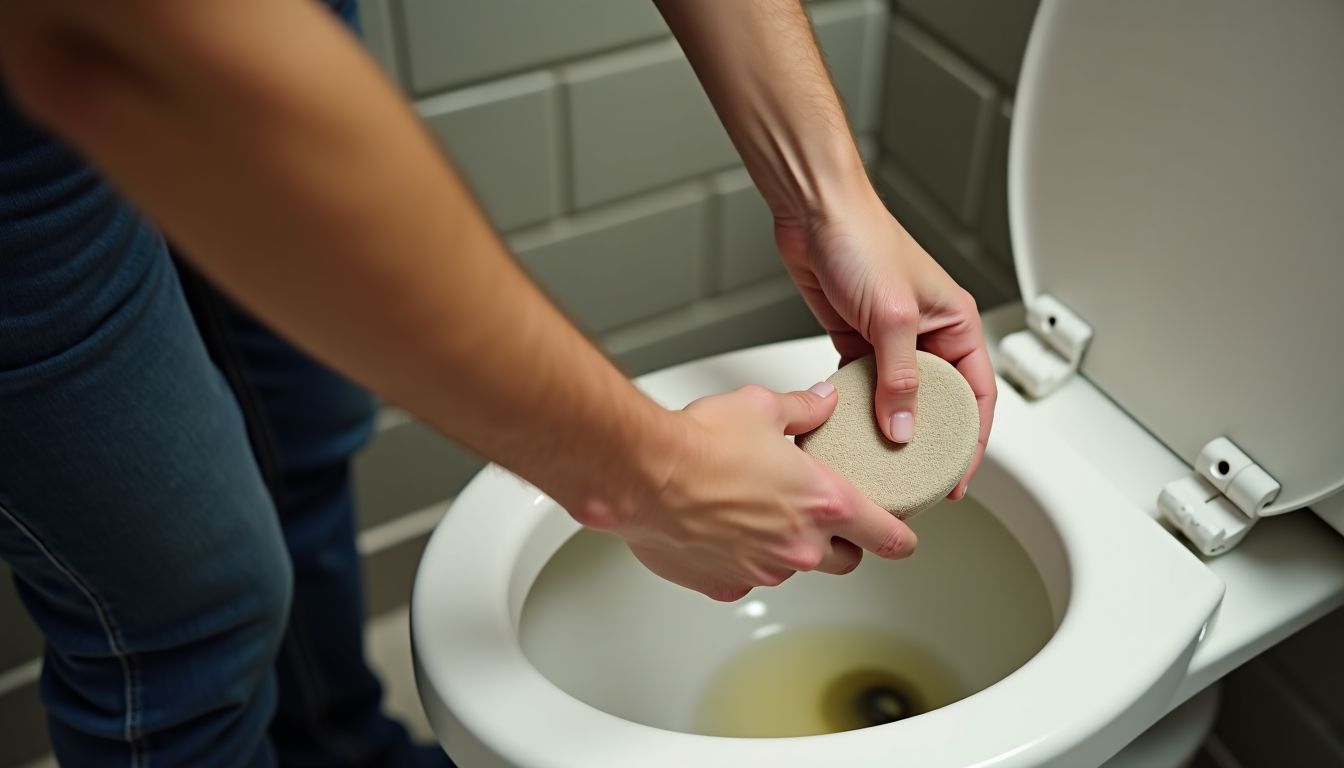
Toilet bowl stains can be persistent, but there are effective methods to tackle them. Using natural remedies like vinegar and baking soda or trying a pumice stone can provide excellent results.
Moreover, consistent cleaning schedules and the installation of a water softener can help prevent future stains from forming. With these practical tips in mind, house owners and parents can maintain a clean and sanitary bathroom environment for their families.
FAQs
1. What are common stains found in toilet bowls?
Common stains in toilet bowls include hard water deposits, rust, and mildew. These stains can make your toilet look dirty and uninviting.
2. How can I clean tough stains from the toilet bowl?
To clean tough stains, use a mixture of baking soda and vinegar. Pour it into the bowl, let it sit for 30 minutes, then scrub with a toilet brush before flushing.
3. Are there specific cleaners that work best for toilet bowl stains?
Yes, cleaners containing bleach or hydrochloric acid effectively remove stubborn stains. Always follow the instructions on the label for safe usage.
4. How often should I clean my toilet to prevent staining?
Clean your toilet at least once a week to prevent staining and buildup. Regular cleaning keeps your bathroom fresh and hygienic.





